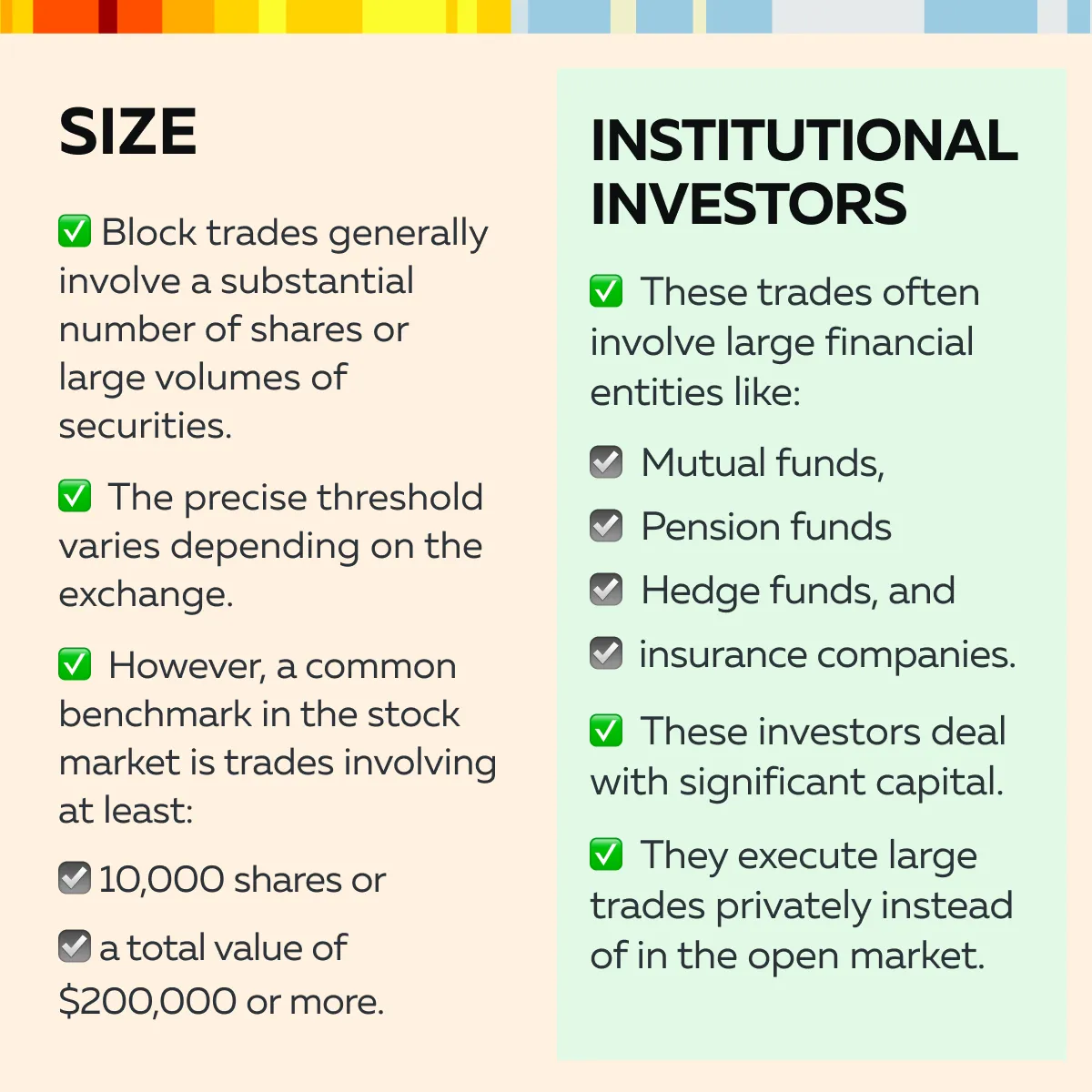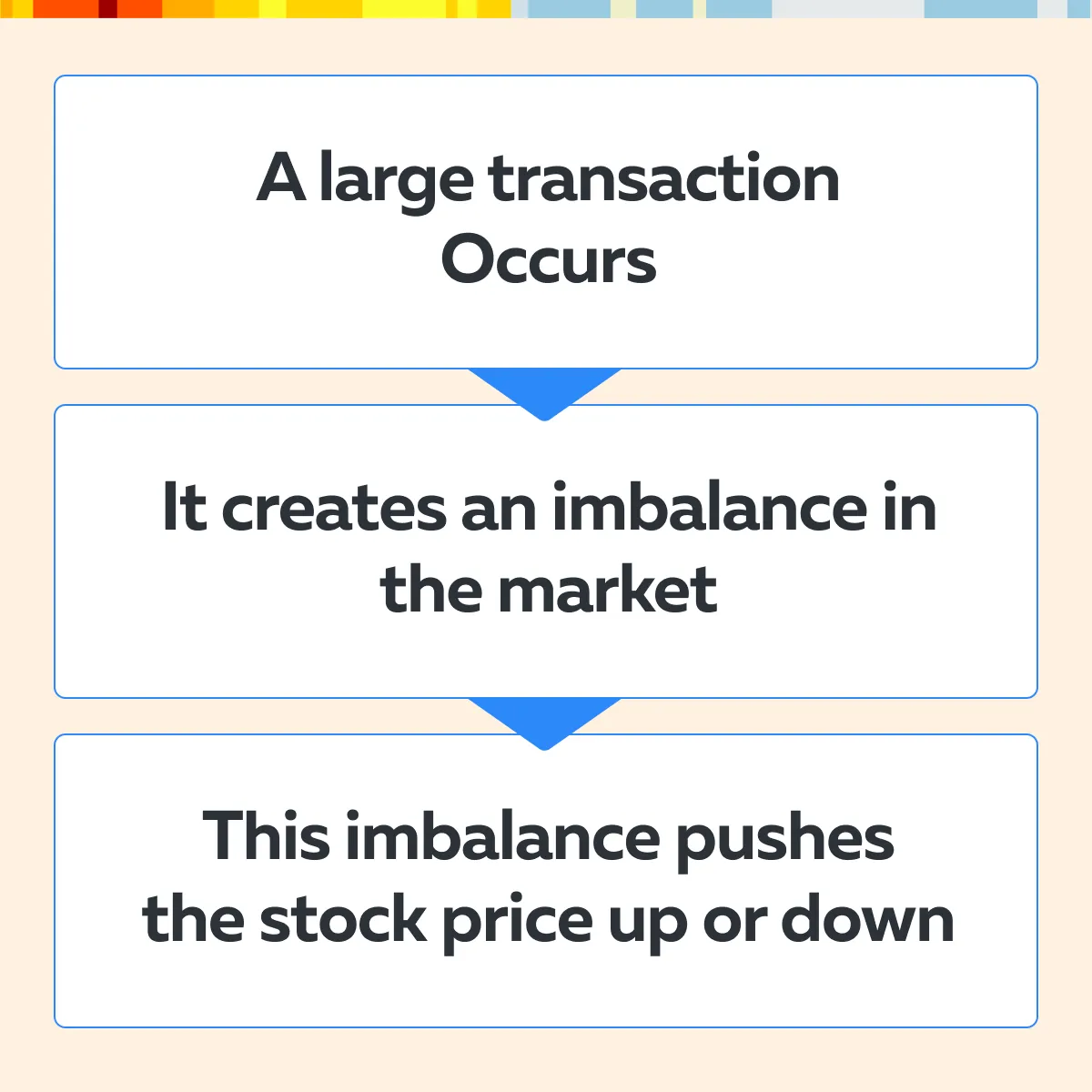Ready to see the market clearly?
Sign up now and make smarter trades today
Stocks
January 3, 2025
SHARE
The Impact of Block Trades on Stock Prices: What Retail Traders Should Know
Have you ever wondered how a single trade could make a stock dive or surge in seconds? This magic happens due to something called “block trades.” Here, the big players (like hedge funds and pension funds) make moves that can shake up the market.
Do you wish to know how? Read this article to learn what block trades are and why they matter, not just for institutional investors but also for everyday traders.
We’ll start by exploring how block trades work and why they are often conducted away from public exchanges. You’ll see how institutions use methods like dark pools to keep these massive transactions hidden. Also, we’ll discuss the impact these trades have on stock prices and market liquidity, especially in low-volume stocks. For those wondering how these large trades influence volatility and why prices can swing so wildly, we have answers.
Finally, we’ll cover how retail traders can use advanced tools, like our platform, Bookmap, to monitor block trades and adjust their strategies. Let’s get started.
What Are Block Trades?
Block trades refer to large, privately negotiated transactions involving the buying or selling of significant quantities of a stock or other security. These transactions are mostly executed outside of the public exchange. The reason for executing block trades outside the regular market is to minimize the impact such large orders could have on the stock’s price. For more clarity, let’s have a look at some characteristics of block trades:

Why Block Trades Occur Privately?
When a massive order is placed in the open market, there is always a possibility of price fluctuations. This happens due to supply and demand dynamics. For example,
- Let’s consider that a hedge fund tried to purchase 1 million shares of stock in the open market.
- This purchase increases the demand for the stock.
- This increased demand also surges the stock price up before the order is fully executed.
- As a result, the transaction becomes more expensive for the buyer.
- In contrast, selling a substantial block of shares could depress the stock price.
To prevent these price disruptions, block trades are arranged privately. They usually happen through brokers or investment banks. These intermediaries find a buyer or seller willing to transact the large block at an agreed price without it being visible on the public exchange.
Now, let’s enhance our understanding and study an example of a block trade:
Let’s consider that a hedge fund wants to purchase 1 million shares of Company XYZ. If they placed this buy order directly on a public exchange, the surge in buying demand would likely increase the stock price before the entire order could be fulfilled.
To avoid this, the hedge fund negotiates the transaction privately. They negotiate with a broker who facilitates the block trade. This approach helps maintain a stable price, and the hedge fund gets a better deal. The broker may:
- look for a seller willing to provide all the shares later
or
- break up the block trade into smaller components to place them strategically on the market at their discretion.
The Impact of Block Trades on Stock Prices
Be aware that block trades can significantly influence stock prices. Their effect is felt even more in cases where the stock is relatively low in trading volume and lacks ample liquidity. This effect is closely linked to the basic economic principles of supply and demand. Check the graphic below:

How Do Block Trades Affect Prices?
It must be noted that stocks that have lower daily trading volumes are more susceptible to price fluctuations when faced with large trades. In these stocks, even relatively small orders have a notable impact on the price. So, a block trade causes sharp price movements.
Moreover, a block trade creates an excess of supply or demand that the market struggles to absorb immediately. Let’s understand better through two different scenarios:
| Scenario I: Buy-Side Block Trade | Scenario II: Sell-Side Block Trade |
|
|
Let’s also check out an example scenario:
- Let’s consider that there is a low-volume stock.
- It usually trades only a few thousand shares per day.
- In this stock, an institutional investor decides to execute a buy-side block trade of 100,000 shares.
- The demand for stock increases dramatically.
- Given the limited liquidity, this trade temporarily drives up the stock price.
- Most buyers scramble to meet the sudden demand.
- Contrarily, if there is a sell-side block trade, it causes a steep price drop.
- This happens because the influx of shares on the market exceeds the typical daily demand.
What is the Effect of Block Trades on Market Liquidity?
Liquidity refers to how easily shares can be traded without causing any significant fluctuations in the stock’s price. When a large institutional investor executes a block trade, the liquidity on either the bid or ask side of the order book is usually reduced. This affects the trading conditions for other market participants. Let us read how this might occur.
| Consumption of Order Book Depth | Effect on Bid-Ask Spreads | Slippage |
|
|
|
For more clarity, let’s check out an example:
- Say that a mutual fund places a large buy-side block trade for an illiquid stock.
- This trade consumes most of the shares available at the current ask prices.
- This increases the share price.
- Market makers adjust to the reduced supply of shares.
- Retail traders who attempt to buy the stock after this block trade experience slippage.
- Their orders get filled at higher prices.
- Additionally, they see a wider bid-ask spread.
- This makes it more expensive to trade for them.
In this way, block trades create a less favorable environment for regular market participants. Generally, the significant consumption of liquidity due to block trades alters normal market conditions.
Block Trades in Low-Volume Stocks: Higher Impact

Block trades have a deep impact on the prices of low-volume stocks. In low-volume stocks, fewer shares are actively traded on a regular basis. The lack of liquidity in these stocks means that even a relatively small number of shares can significantly influence the stock’s price. Now, when it comes to block trades, the effect is even more dramatic. Let’s read about the major impacts block trades usually have.
Impact I: Exaggerated Price Effects
In highly liquid stocks, such as Apple or Microsoft, which trade millions of shares daily, block trades are usually absorbed with minimal impact on the price. However, low-volume stocks do not have this level of market depth. This makes them far more sensitive to large trades. When a block trade occurs in such stocks, it causes a significant price swing.
For example:
-
- Let’s assume that a hedge fund executes a $5 million block trade in a low-volume stock.
- This stock mostly trades only $1 million worth of shares per day.
- This sudden influx of buying or selling pressure pushes the stock price up or down by 5% or even more.
- Be aware that the percentage change entirely depends on the existing order book and market conditions.
- In comparison, the same $5 million trade in a high-volume stock like Apple would have a negligible impact.
- That’s because the market could easily absorb the trade without disrupting the price.
Impact II: Volatility Consideration
Block trades in low-volume stocks also increase price volatility. The sudden and substantial price movements create unpredictable trading conditions. This makes it more difficult for retail traders to:
- anticipate price trends
or
- set effective stop-loss and take-profit orders.
This added volatility is particularly challenging for traders who prefer stable price patterns. Institutions sometimes exploit this volatility to their advantage by strategically placing large block trades. This strategy moves the stock price in a favorable direction. Then, they quickly exit the position to capitalize on the movement. These actions further amplify price swings and complicate trading for smaller market participants.
How Block Trades Are Executed?

Mostly, block trades are executed off-exchange. Such an execution minimizes the market impact of large transactions. Usually, this process involves using dark pools or private negotiations between large financial institutions. This setup ensures that their large trades are handled efficiently and discreetly. Let’s understand both these setups of off-exchange trading in detail:
| Dark pools | Private negotiations |
and
|
|
For example:
- Say a pension fund wants to sell a substantial number of shares in a company.
- If the sale were to occur openly on the stock market, it could lead to a sharp drop in the stock price.
- Instead, the pension fund uses a dark pool to sell the shares discreetly.
- This setup minimizes the market impact.
- Retail traders are kept unaware of the transaction details.
- This reduces the risk of front running.
Want to track large institutional trades in real-time? Use Bookmap’s advanced market analysis tools to gain insight into block trades.
What is the Market Impact Post-Execution?
Although block trades are executed off-exchange, they still affect the stock’s price once reported. By regulation, these trades must be disclosed publicly within a certain time frame. When the details of a block trade become available, the market may react significantly.
Once the block trade is made public, retail traders and other market participants often respond based on the information. If an institutional investor has purchased a large amount of stock, it signals confidence in the company’s future performance. This prompts traders to buy more shares. This spike in buying pushes the price higher. On the other hand, a large sell order indicates bearish sentiment. This leads to additional selling pressure.
How Retail Traders Can Respond to Block Trades?
Retail traders are often at a disadvantage compared to institutional investors when it comes to:
- information
and
- trading speed.
However, they can still take strategic steps to respond to block trades. By monitoring and analyzing the effects of these trades, retail traders can make informed decisions. They can protect or even capitalize on market movements. Let us check out some popular tools.
Tools for Monitoring Block Trades
Retail traders can use various tools to stay informed about block trades:
- FINRA’s Trade Reporting and Compliance Engine (TRACE)
TRACE is a system used to report large trades. It allows traders to monitor block trades in equities. By keeping an eye on “block trade reports,” retail traders can understand how significantly institutional activity might influence the market.
- Order Flow and Liquidity Analysis Tools
Our advanced market analysis tool, Bookmap, provides real-time insights into:
- market depth,
- order flow,
and
- liquidity.
Using it, retail traders can easily highlight significant shifts in supply and demand. This gives retail traders a clearer picture of how large orders, such as block trades, affect the market. For more clarity, let us see an example:
- Say a retail trader is using Bookmap.
- They notice a sudden depletion of liquidity on the buy side of the order book.
- This depletion shows that a large sell-side block trade has occurred.
- This insight helps the trader to decide whether to hold, sell, or hedge their position.
How to Respond to Block Trades?

Once a retail trader identifies a block trade, they can adjust their trading strategy. This reduces the impact of the trade. Here are some approaches:
Approach I: Managing Risk After Large Sell Orders
If a retail trader observes a large block sell trade in a stock they are holding, it indicates:
- bearish sentiment,
or
- unloading of a large block of shares by an institution.
In response, the trader could do the following:
| Exit or Reduce Their Position | Use Stop-Loss Orders |
| To manage risk, the trader might choose to sell some or all of their shares. They can follow this technique, especially if the block trade puts downward pressure on the stock price. | By setting a stop-loss order, traders can limit their potential losses. This gives protection when the price continues to decline following the block trade. |
Approach II: Capitalizing on Large Buy Orders
If a trader notices a substantial block buy trade, it signals institutional confidence in the stock. This could lead to a price increase. Now, the trader could:
| Enter or Increase Their Position | Monitor for Reversals |
| If the fundamentals align with the trader’s analysis, they might choose to buy or add more shares. By doing so, they can hope to benefit from the upward momentum. | Even after a large buy trade, prices can experience volatility. Retail traders should stay alert for any signs of a price reversal before committing fully. |
Let us understand better through an example:
- Say a retail trader notices through Bookmap that a large block sell trade has just occurred in a stock they own.
- The trader sees that the bid side of the order book has thinned out.
- This situation suggests a price drop.
- To mitigate risk, they decide to:
- sell half of their position
and
- set a stop-loss order for the remainder at a strategic level.
- Alternatively, if the trader believes the block trade created an overreaction, they might wait for a chance to buy the stock back at a lower price.
Conclusion
Block trades are large and privately negotiated transactions. They are often used by institutional investors like hedge funds or mutual funds. Through these transactions, they buy or sell substantial amounts of stock without causing major disruptions in the market. These trades are usually executed off-exchange, using methods like dark pools. This keeps the institutions’ intentions hidden and prevents price movements that would otherwise occur if the trades were made in the open market.
However, block trades still have a significant impact on stock prices and liquidity, especially in low-volume stocks. When these large trades occur, they cause sudden and exaggerated price movements. This reduces available liquidity and increases volatility. Such a situation makes it harder for retail traders to predict price changes.
To monitor and optimize trading during these times, retail traders can use tools like FINRA’s TRACE and our advanced market analysis tool “Bookmap.”Bookmap’s order flow and liquidity analysis can help you identify the impact of large trades before they affect the market.
